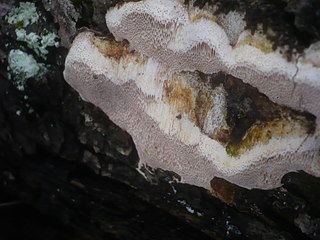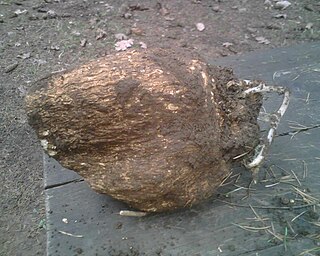
The Polyporales are an order of about 1800 species of fungi in the division Basidiomycota. The order includes some polypores as well as many corticioid fungi and a few agarics. Many species within the order are saprotrophic, most of them wood-rotters. Some genera, such as Ganoderma and Fomes, contain species that attack living tissues and then continue to degrade the wood of their dead hosts. Those of economic importance include several important pathogens of trees and a few species that cause damage by rotting structural timber. Some of the Polyporales are commercially cultivated and marketed for use as food items or in traditional Chinese medicine.

The Hymenochaetales are an order of fungi in the class Agaricomycetes. The order in its current sense is based on molecular research and not on any unifying morphological characteristics. According to one 2008 estimate, the Hymenochaetales contain around 600 species worldwide, mostly corticioid fungi and poroid fungi, but also including several clavarioid fungi and agarics. Species of economic importance include wood decay fungi in the genera Phellinus and Inonotus sensu lato, some of which may cause losses in forestry. Therapeutic properties are claimed for Inonotus obliquus ("chaga") and Phellinus linteus, both of which are now commercially marketed.

Junghuhnia is a genus of crust fungi in the family Steccherinaceae. It was circumscribed by Czech mycologist August Carl Joseph Corda in 1842. The generic name honours German-Dutch botanist Franz Wilhelm Junghuhn.

The Polyporaceae are a family of poroid fungi belonging to the Basidiomycota. The flesh of their fruit bodies varies from soft to very tough. Most members of this family have their hymenium in vertical pores on the underside of the caps, but some of them have gills or gill-like structures. Many species are brackets, but others have a definite stipe – for example, Polyporus badius.
Abundisporus is a small genus of poroid fungi currently with seven recognized species. They differ from other polypores in having coloured rather than hyaline spores.

Perenniporia is a cosmopolitan genus of bracket-forming or crust-like polypores in the family Polyporaceae. They are dimitic or trimitic with smooth, thick-walled basidiospores and cause a white rot in affected wood.

Fomitopsis is a genus of more than 40 species of bracket fungi in the family Fomitopsidaceae.

Wolfiporia is a genus of fungi in the family Polyporaceae. The genus was circumscribed by Leif Ryvarden and Robert Lee Gilbertson in 1984 to contain the type species Wolfiporia cocos and W. dilatohypha. The genus is named in honor of mycologist Frederick Adolph Wolf, who was the first to officially describe the type species.

Fomitiporia is a genus of fungi in the family Hymenochaetaceae. According to a 2008 estimate, the widely distributed genus contains 11 species, though three new species were identified in 2010 in sub-Saharan Africa using multigene molecular phylogenetic analysis, and two more were named in a 2013 article. In 2011 it was announced that a specimen of the species F. ellipsoidea was discovered with a fruit body that is largest known of any fungus. However, the species has since been moved to Phellinus.

Haploporus is a genus of poroid fungi in the family Polyporaceae.

Ceriporia is a widely distributed genus of crust fungi.

Antrodiella is a genus of fungi in the family Steccherinaceae of the order Polyporales.
Grammothele is a genus of poroid crust fungi in the family Polyporaceae.
Megasporoporia is a genus of four species of crust fungi in the family Polyporaceae. The genus is characterized by its large spores, and dextrinoid skeletal hyphae.

Skeletocutis is a genus of about 40 species of poroid fungi in the family Polyporaceae. The genus has a cosmopolitan distribution, although most species are found in the Northern Hemisphere. It causes a white rot in a diverse array of woody substrates, and the fruit bodies grow as a crust on the surface of the decaying wood. Sometimes the edges of the crust are turned outward to form rudimentary bracket-like caps.
Phellinopsis is a genus of four species of fungi in the family Hymenochaetaceae. It was newly circumscribed in 2010, containing P. occidentalis and the type species P. conchata. P. junipericola and P. resupinata were added in 2012, and P. asetosa in 2015.
Fomitiporia nobilissima is a fungus in the family Hymenochaetaceae. Found in Gabon, it was described as new to science in 2010.
Fomitiporia gabonensis is a fungus in the family Hymenochaetaceae. It was first isolated from Sub-Saharan Africa, specifically in the Guineo-Congolian forest. It has a pileate basidiome, small basidiospores and an absence of setae. Morphological features that differentiate this species with F. nobilissima and F. ivindoensis are its pileus' shape, pore surface color and diameter, as well as its ecology.
Fomitiporia ivindoensis is a fungus in the family Hymenochaetaceae. It was first isolated from Sub-Saharan Africa, specifically in the Guineo-Congolian forest. It has a pileate basidiome, small basidiospores and an absence of setae. Morphological features that differentiate this species with F. nobilissima and F. gabonensis are its pileus' shape, pore surface color and diameter, as well as its ecology.

Inocutis is a genus of nine species of polypore fungi in the family Hymenochaetaceae.













